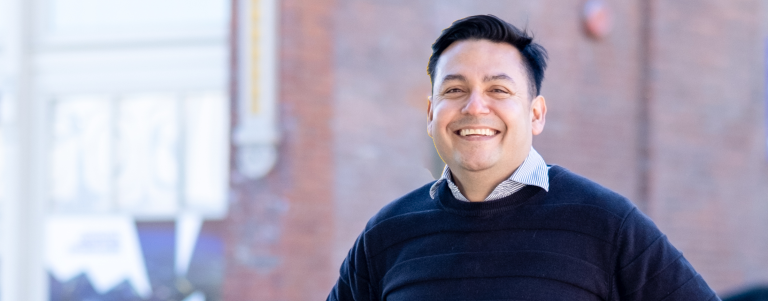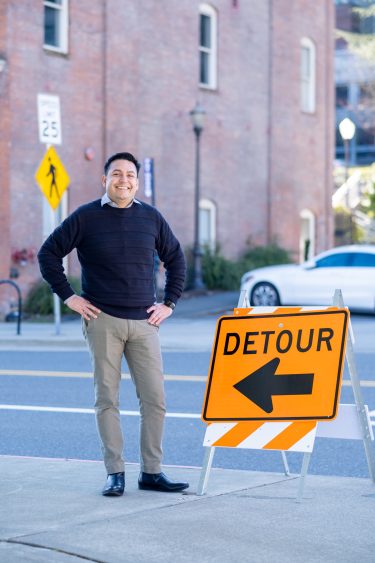Published on November 22, 2022

This is the first in a series of interviews from Urban@UW highlighting the research of urban scholars at the University of Washington. Earlier this month, Urban@UW spoke to Rubén Casas, Assistant Professor in the School of Interdisciplinary Arts and Sciences and Adjunct Assistant Professor in the School of Urban Studies at the University of Washington Tacoma. The interview has been edited for length and clarity.
What do you do at the University of Washington?
I am a faculty member, so my responsibilities are typically split between teaching and research, and a lot of my research is community-engaged. And then I do a fair amount of service to the university, including serving on committees and bodies, both on the Tacoma campus and across the university.
I am part of the Writing Studies faculty on the Tacoma campus. I came to UW Tacoma to help develop a new option in the major focused on community-engaged writing. So whereas so much of the writing instruction that students get at this or any other university is geared towards academic writing, this new track is actually the opposite. We are thinking of the type of writing that you would do for nonprofits, in professional settings, and in advocacy settings, that are written for public audiences, not for academic audiences.
I also have an affiliation with Urban Studies on the Tacoma campus, which is partly how I’m connected to Urban@UW.
Can you tell us about your research?
I’m finishing up a project that I conducted with another professor in Urban Studies, Dr. Anaid Yerena. We initially wanted to know how long are people in Tacoma commuting, and does that correlate to how, when, or if they’re using pretty excellent neighborhood parks. So that was the original plan. And then the pandemic hit and suddenly [many people were not] traveling for work. But then someone asked us what we thought about cities closing down parks in the early days of the pandemic.
When we saw that an original response to the pandemic was to restrict access to parks, we wondered if this was a good idea. Then we realized that perhaps we needed to ask a different question: how are people using their parks in and through the pandemic, and can parks do more than what they currently do? When we asked that question, that took us out to see how other nations build and program parks, and we realized that, compared to how other nations use their parks, we severely limit the use of parks in the US. How? Well, in other countries parks are open 24 hours. And curiously, if you go to most parks in the US, there’s a sign that says the park closes at dusk and doesn’t reopen until dawn.
I also learned that in disaster-prone parts of the world, parks are leveraged toward crisis response. In Japan they have a whole concept called the disaster park in big cities where they have routinely experienced earthquakes and tsunamis. If you live around a park, you know that you can go to that park, and you’re going to find showers, bathrooms, and benches. They have grills and gas and all their light posts have electrical outlets. So during times of crisis these parks become epicenters of aid.
Another thing that happened in 2020 was the outbreak of social unrest across the US around the killing of Black men and women. These sorts of civil rights actions either took place at parks, started at parks, or organized at parks, because they represented a place where people could congregate en masse at a time when we couldn’t be congregating indoors. All of this to say that our project took on a different focus, and we realized that whereas the initial question we were asking could not really be answered through the pandemic, this new question was another interesting question we could ask.
Honestly, I think for me the biggest thing I’ve taken away from the parks project, and I still think about it a lot, is how limited our thinking and imagination is around parks.
We ended up conducting surveys online and structured observations of parks, and then we most recently did in-person interviews with people at a park here in Tacoma. Ultimately what we are moving forward with is some recommendations to cities and park districts who may want to rethink the potential of parks in ways that could be leveraged toward better disaster or crisis response, but also that could better lend themselves to social activity and to causes around civil rights.
Dr. Yerena and I are also beginning a new project which we’re calling “Decoding the Anti-Racist City.” Our own mayor here in Tacoma ran a successful second campaign with the promise to make Tacoma an anti-racist city. And initially we’re thinking, what does that mean, how does a city get to be anti-racist? And we realized that it wasn’t unique to Tacoma. A lot of cities around the US have officials, mayors, and city council people that have made similar pronouncements. And it’s unclear what they actually mean when they say that. Also we don’t know where they locate racism in the city. Is it in governance? Is it in policing? And our other question following that is, on who or what is the the responsibility of making it anti-racist? We’ve identified five mid-size cities across the US where officials have made pronouncements of this kind, and we’re going to dig into that question, hoping to come out on the other end with some sense of what leaders mean when they say that, whether it’s possible, and if it is possible, what are some best practices around that.

Image credit: Ryan Moriarty
What has surprised you most about your research?
Honestly, I think for me the biggest thing I’ve taken away from the parks project, and I still think about it a lot, is how limited our thinking and imagination is around parks. If you travel through Europe or Latin America, you realize that parks and plazas are where people hang out in the evenings and on the weekends and young people go there, and it’s ten o’clock at night and the park is busy. You’re bound to run into your friends and neighbors there. And parks can do a lot more in times of social unrest, and they have, we just don’t have a long memory about that. But parks can be spaces that can be activated during times of social unrest and in the pursuit of justice. I love parks, but prior to doing this project, I couldn’t have told you that I could love them even more because of everything that they could potentially do on our behalf if we were to leverage them in a more robust way.
What kind of partnerships within UW or outside of UW do you engage in through your work?
With the parks project we collaborated with Metro Parks Tacoma. And in this new project we’re working with the City of Tacoma, and it happens to be that my collaborator is part of the committee that the mayor has constituted to look into how we make the city an anti-racist city.
I consult with a Home in Tacoma city planner, who is overseeing the revision of the city code to bring more housing equity to the city. I also am a transportation commissioner for the city. Another community partner that I do work with pretty extensively is Tacoma Tree Foundation, a group that attempts to apply an environmental justice and equity lens in trying to address a really big issue in our city.
Collaboration, partnership, and consultation are the three levels of relationships that I seek to cultivate.
The City of Tacoma has recently funded what they’re calling a Climate Leadership Cohort where they’re recruiting, training, and professionalizing young people in the city to start making change around climate resilience, and I’m working in a support role, also through my role at Urban@UW through the Urban Environmental Justice Initiative, to give them capacity to do that by running workshops and networking with other professors and experts across the UW.
Is there any way for students to get involved either with your work or in any of the organizations that you’re part of?
One of my greatest joys of being an academic is working with students. And in these projects, we have deliberately worked to be able to pay students to take part in the research. In the parks project we involved five undergraduate research assistants, and then for this for this project on the anti-racist city, we’re looking to work with four students.
I’m currently working with the Tacoma Tree Foundation to try to institute some type of sponsored internship with them in the summers to help them support some of their work. I also hope to help create avenues for students to take part in projects sponsored by the city, across various issues and situations, including housing and land-use policy, transportation policy, and climate resilience.
If you could give aspiring urban scholars a piece of advice, what would it be?
Locate your interest in your neighborhood, in your community. Sometimes things get really big and complicated, and you realize that there are all these competing values, and it’s not always easy to say who’s right and who’s wrong here. Okay, let’s think about how we can apply what we’re learning to our street, our neighborhood, our city. So the advice I would give to a student is okay, you realize you have an interest in urban systems. Where do you see a role for the knowledge that you’re getting in your community? Keep it local.
What is something coming up that you are excited for?
What day is it today? Because we have pizza every Wednesday night, which is my favorite night of the week, because I love pizza.
I’m going to present this paper on what we’re calling The Just Park at a conference in Toronto. I’ve been to Toronto once and fell in love with that city, so I’m excited to go back. I’m only going to be there for two days, but other than giving my presentation, I plan to walk a lot and eat a bunch of good food.
Edited by Logan Bridge for Urban@UW